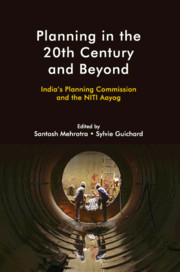Book contents
- Frontmatter
- Contents
- List of Figures
- List of Tables
- List of Abbreviations
- 1 Planning for a 21st Century India
- Part I Origins: Ideas and Ideology
- 2 From Economists to Historians: Studying the Planning Commission, 1950–2014
- 3 The Long Road to Indian Economic Planning (until 1950)
- 4 Ideas and Origins of the Planning Commission in India
- Part II Changes and Continuity: Development and Adaptation of Planning and the Planning Commission
- 5 The Planning Commission and Education
- 6 Addressing Agrarian Distress: Sops versus Development
- 7 Economic Planning after Economic Liberalization: Between Planning Commission and Think Tank NITI, 1991–2015
- 8 Planning Commission: Obiter Dictum
- 9 On a Revived Planning Commission
- Part III Planning Beyond the Planning Commission
- 10 Make in India
- 11 Manufacturing: The Cornerstone of a Planning Strategy for the 21st Century
- 12 Fiscal Planning to Sustain Growth and Poverty Reduction
- 13 Plan, but Do Not Over-plan: Lessons for NITI Aayog
- 14 Why Does India Need a Central Planning Institution in the 21st Century?
- Notes on Contributors
- Index
- References
9 - On a Revived Planning Commission
Published online by Cambridge University Press: 04 April 2020
- Frontmatter
- Contents
- List of Figures
- List of Tables
- List of Abbreviations
- 1 Planning for a 21st Century India
- Part I Origins: Ideas and Ideology
- 2 From Economists to Historians: Studying the Planning Commission, 1950–2014
- 3 The Long Road to Indian Economic Planning (until 1950)
- 4 Ideas and Origins of the Planning Commission in India
- Part II Changes and Continuity: Development and Adaptation of Planning and the Planning Commission
- 5 The Planning Commission and Education
- 6 Addressing Agrarian Distress: Sops versus Development
- 7 Economic Planning after Economic Liberalization: Between Planning Commission and Think Tank NITI, 1991–2015
- 8 Planning Commission: Obiter Dictum
- 9 On a Revived Planning Commission
- Part III Planning Beyond the Planning Commission
- 10 Make in India
- 11 Manufacturing: The Cornerstone of a Planning Strategy for the 21st Century
- 12 Fiscal Planning to Sustain Growth and Poverty Reduction
- 13 Plan, but Do Not Over-plan: Lessons for NITI Aayog
- 14 Why Does India Need a Central Planning Institution in the 21st Century?
- Notes on Contributors
- Index
- References
Summary
Introduction
Indian planning never was the caricature that corporate types and their journalist and political hangers on make it to be – of a Soviet centralized Gosplan – and there was always a Gandhian leg of decentralized development, in addition to the Nehruvian one of technological modernization (see Alagh 1991a, 1998). But the introduction of markets systematically into decision making of governments at different levels in a Federal setup goes back to the reforms initiated by Rajiv Gandhi in his altogether brief stint as a national leader. In fact, in terms of ideas little happened after that. India then developed the structure of an economic policy apparatus of a strategically driven system with long-term objectives. This was in 2014 dismantled by the National Democratic Alliance (NDA) government. However, given the compulsions of the system and political developments already under way, strategic planning in a market economy will revive.
In its present avatar, the National Institution for Transforming India, or NITI Aayog, is meant to do studies and arrange discussions on policy issues ( according to the government's notification establishing NITI in early 2015). As a number of commentators have pointed out, there is no need to have a government organization for this purpose, and there is no special reason to do studies in a government organization. India has a set of excellent institutions working on development issues. Studies can be better done there rather than in a bureaucratic set-up. The Chinese National Development and Reform Commission does studies, it is pointed out, and it is the successor to the State Planning Committee, but the Chinese body also has a resource allocation role. At present, the Indian federal polity is under strain with the abolition of rule-based allocation systems although it is working in the context of the rump of the Twelfth Five-Year Plan. What is it argued will happen since? I believe that the planning function will have to be revived. Planning reform has in fact been an issue earlier.
The predecessor Planning Commission was charged by the then Prime Minister Dr Manmohan Singh to examine the reform of the planning process. In fact, the process was an ongoing one. From the Eighth Plan onwards, as also in the Review documents of the Tenth and Eleventh Plans, there was considerable discussion on the reform of the planning process.
- Type
- Chapter
- Information
- Planning in the 20th Century and BeyondIndia's Planning Commission and the NITI Aayog, pp. 167 - 184Publisher: Cambridge University PressPrint publication year: 2020



